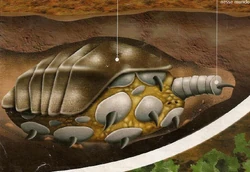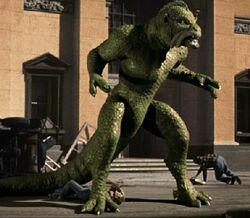(→Types) |
(Adding categories) |
||
| Line 41: | Line 41: | ||
[[Category:Futurama Universe]] |
[[Category:Futurama Universe]] |
||
[[Category:Brewster Rockit Universe]] |
[[Category:Brewster Rockit Universe]] |
||
| + | [[Category:Races of the Sol System]] |
||
Revision as of 02:33, 19 April 2010

A creature from Venus, featured in the magazine Superinteressante in 1999

The Ymir, a Venusian beast from the movie 20 Million Miles to Earth
Venusians are extraterrestrial beings which originated on Venus, the second planet of the Sol System.
Native inhabitants of Venus are a very popular concept in science fiction, having been depicted in many different forms: from beautiful humanoids to strange sulfur-based lifeforms. The subject has also attracted interest from ufology and astrobiology, as, in spite of the harsh environment found on the planet, the existence of life on Venus – at least microbial life – is still considered possible nowadays.
History
Historically, Venus has always been viewed with interest by early astronomers. The fact that it is closer to the sun and is entirely covered in dense clouds gave the idea of a hot, moist tropical world, which in turn gave an idea of primitiveness. Early science fiction stories often had Venus depicted as a swamp planet, a primitive world similar to what Earth might have been in the Carboniferous period. Another popular theory was that Venus could be a world completely covered by oceans, either made of water or of other substances.
The true nature of the planet was not revealed until the late 50s, when astronomers were able to measure the temperature of Venus and found out that, thanks to a gigantic greenhouse effect caused by the high amount of carbon dioxide in the atmosphere, the temperature easily reaches more than 450ºC on the surface of the planet. This means that life as we know it is probably impossible, at least on the surface.
However, astrobiologists say that there is still a good chance of finding microorganisms living in Venus' clouds, where the temperature is much more appropriate. The existence of microbes living permanently in Earth's clouds seems to support this idea. By analyzing the atmosphere of Venus, scientists have found evidences that biological activity seems to be going on (read more here). Also, we now know that Venus was once an Earth-like planet covered by oceans, so it is possible that life originated there in the past.
Types
- Semi-sapient creatures living in the oceans of Venus in the novel Last and First Men.
- Lucky Starr and the Oceans of Venus, a story by Isaac Asimov, depicts Venus as an ocean planet and describes many native species, both fauna and flora.
- In Isaac Asimov's short story The Watery Place, two Venusians land their flying saucer in a small city in Idaho and try to make contact with the local sheriff, who is too busy working on his taxes to pay attention to them. The aliens appear exactly human, their true appearance being never revealed. Only after they go away does the sheriff see their spaceship and realize they were extraterrestrials, not italians as he had thought ("Venus! When they talked about the watery place, I thought they meant Venice!").
- The Ymir is a large reptilian creature from Venus in the film 20 Million Miles to Earth.
- Venusians were depicted as small, non-sapient fossorial creatures in the Brazilian magazine Superinteressante.
- The book Venus, by Ben Bova, includes non-sapient, snake-like Venusians which use molten sulfur for blood, and microorganisms that live high in the atmosphere and break down ceramics and metals for their metabolism.
- In Doctor Who and Futurama, Venusians have been mentioned at times, but never seen, although there are indications that the Blobs, an amorphous species in Futurama, may actually be from Venus.
- In the comic strip Brewster Rockit: Space Guy! the character Ursula claims to be from Venus. Also, a Venusian Groundhog was featured in the strip in February 2 (Groundhogs Day), 2009.
- In ufology, Venusians are usually described as humanoid beings.